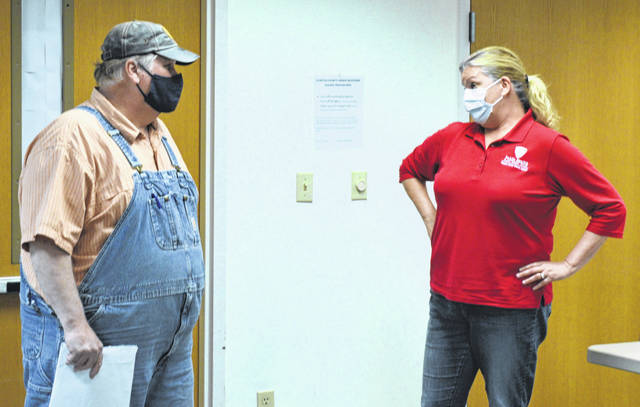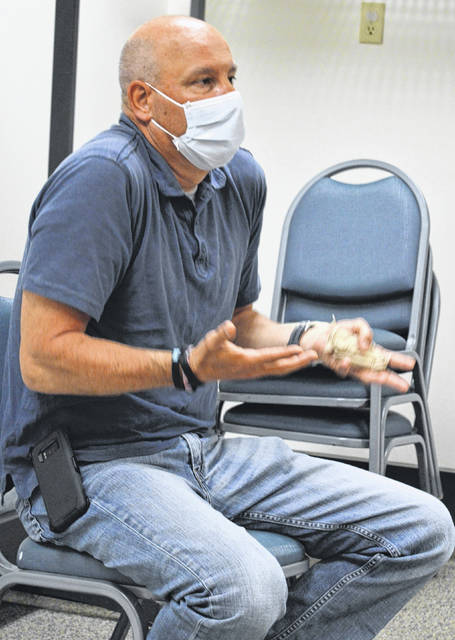

WILMINGTON — The Clinton County Health District has received $44,807 earmarked for contact tracing.
Contact tracing is a disease-control measure employed by health departments personnel for decades, and is a key strategy for minimizing the spread of COVID-19. In contact tracing, public health staff work with a patient to help them recall everyone with whom they have had close contact during the time frame while they may have been infectious.
Public health staff then warn those exposed individuals — contacts — of their potential exposure.
Clinton County Health Commissioner Pam Bauer said, “All the [Clinton County Health Department] nurses know how to do this. They pretty much do this all the time [as part of their job].”
The remainder of the local Health Department staff has also been trained how to do contact tracing, she said. Clinton County’s numbers of COVID-19 patientshave fortunately not risen to the level where the non-nurse staffers have had to reinforce the local contact tracing efforts, said Bauer.
The amount of the COVID-19 federal grant received by Clinton County for contact tracing is based on the county’s population, she said during Monday’s meeting of the Clinton County Board of Health.
The health commissioner reported on the local Health Department’s inventory of personal protective equipment (PPE). They are doing fine with face masks, have “oodles of gloves,” but consistent with a nationwide shortage are short on gowns.
To counter the shortage here, Clinton County Emergency Management Agency (EMA) Director Thomas Breckel has purchased every rain poncho he could find in a three-county radius, said Bauer.
In terms of phone calls to the Health Department from the public, there have been some complaints about local people not wearing facial coverings, but mainly the callers are asking questions, she said.
Clinton County Environmental Health Director Matt Johannes said callers from businesses want advice and want to know how to interpret some of the state’s guidelines.
“Even their [state’s] guidance documents contradict themselves,” said Johannes.
During conference calls with other local public health colleagues in the southwest Ohio region and around Ohio, he said they try to hash out the guidance documents.
Although in general employees in Ohio are required to wear facial coverings in the workplace, there are six exemptions, noted Johannes, commenting that the last one is very vague.
Bauer said her best example of a valid use of the last exemption is law enforcement employees such as sheriff deputies.
“They feel it’s important this day and age for somebody to see the officer’s face as they’re responding,” said the health commissioner. Officers are not prohibited from wearing facial coverings, but neither it is mandatory.
At one point in Monday’s session, Bauer said, “I like being in this community because everybody seems to really be trying to work together to wrap their heads around this. We have not received a lot of the negative calls that some of my colleagues in other communities have received. I think that’s just kind of a testament to this community in being realistic and reasonable.”
Probably the biggest enforcement issue locally, said Bauer, involved East Fork Motor Cross on Saturday, May 2. She said they were supposed to just do some training in a limited way, but ended up having spectators who gathered.
During Monday’s session, Clinton County Board of Health members were provided a copy of a letter that the Clinton County commissioners wrote to Ohio Governor Mike DeWine. In the letter, the three county commissioners asked that there be more local control in responding to the coronavirus because different locales have differed in their scale of outbreak.
After noting that county commissioners from other Ohio counties had written letters along the same lines to the governor, Bauer commented that she understands that the letter from Clinton County was put more politely than some of the other county commissioners’ letters. She expressed appreciation that the local letter was “done appropriately.”
After the meeting, Bauer told the News Journal that local confirmed cases of COVID-19 are geographically spread throughout the county. She also reported there have been no confirmed cases of COVID-19 in the long-term care facilities (nursing homes) in Clinton County.
Johannes took the opportunity during the board meeting to say the Clinton County Health Department’s staff had been outstanding during the pandemic. He started with the local health district in 1991, and he said as a whole “This is the best staff we’ve had” during those nearly 30 years.
Reach Gary Huffenberger at 937-556-5768.



